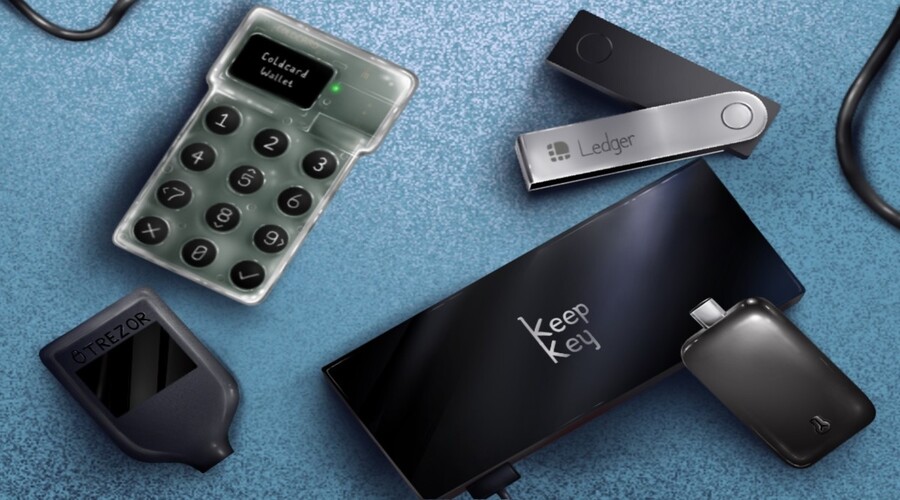When it comes to securely storing cryptocurrencies, hardware wallets have gained significant popularity due to their robust security measures and user-friendly interfaces. These physical devices offer an added layer of protection by keeping the private keys offline and away from potential online threats. In this article, we will compare different hardware wallets available in the market, considering their features, security, compatibility, and user experience. Understanding these factors will help you choose the right hardware wallet for your secure crypto storage needs.
Introduction
Hardware wallets have become a preferred choice for individuals seeking enhanced security for their cryptocurrencies. These devices provide a secure offline environment for storing private keys, minimizing the risk of unauthorized access or hacking. Let’s compare some popular hardware wallets in terms of their features, security, compatibility, and user experience.
What Is a Hardware Wallet?
A hardware wallet is a physical device designed to securely store private keys and facilitate cryptocurrency transactions. It typically connects to a computer or mobile device via USB or Bluetooth, allowing users to manage their digital assets while keeping the private keys offline. Hardware wallets offer a combination of security features, including encryption, secure element chips, and PIN codes, to protect against potential threats.
Ledger Nano X
The Ledger Nano X is a popular hardware wallet known for its advanced security features and extensive compatibility.
– Features
- Wireless Connectivity: The Ledger Nano X offers wireless Bluetooth connectivity, allowing users to manage their cryptocurrencies on-the-go via the Ledger Live mobile app.
- Large Capacity: With its increased storage capacity, the Nano X can support a wide range of cryptocurrencies simultaneously, accommodating diverse portfolios.
- Intuitive Interface: The device features a user-friendly interface and a built-in screen for easy navigation and transaction verification.
– Security
- Secure Element Chip: The Nano X integrates a secure element chip that provides additional protection for the private keys, preventing them from being exposed or compromised.
- PIN Code and Recovery Phrase: Users set up a PIN code during the initial setup, and a recovery phrase is generated to ensure wallet recovery in case of loss or theft.
- Trusted Execution Environment: The Nano X employs a secure execution environment that isolates sensitive operations from potentially compromised devices.
– Compatibility
- Operating Systems: The Ledger Nano X is compatible with Windows, macOS, Linux, iOS, and Android devices, offering broad compatibility across various platforms.
- Cryptocurrency Support: It supports numerous cryptocurrencies, including Bitcoin, Ethereum, Ripple, and many more, making it suitable for diverse cryptocurrency portfolios.
– User Experience
- Ledger Live App: The Ledger Live app provides a user-friendly interface for managing cryptocurrency accounts, checking balances, and initiating transactions.
- Easy Setup: The Nano X offers a straightforward setup process, guiding users through the initial configuration and account synchronization.
Trezor Model T
The Trezor Model T is another popular hardware wallet known for its security features and sleek design.
– Features
- Touchscreen Display: The Model T features a color touchscreen display that enhances user interaction and transaction verification.
- Expandable Storage: It supports an expandable microSD card slot, allowing users to store additional cryptocurrencies and applications.
- Open-Source Software: The Model T’s firmware and software are open-source, enabling transparency and community scrutiny of its security features.
– Security
- Secure Chip: The Model T incorporates a secure chip that isolates private key operations from potentially compromised devices, offering enhanced security.
- PIN Entry on Device: Users enter the PIN directly on the Model T’s touchscreen display, reducing the risk of keylogging attacks.
- Recovery Seed: A recovery seed, generated during the setup process, enables wallet recovery in case of loss or theft.
– Compatibility
- Operating Systems: The Trezor Model T is compatible with Windows, macOS, and Linux systems, providing flexibility for different users.
- Cryptocurrency Support: It supports a wide range of cryptocurrencies, including Bitcoin, Ethereum, Litecoin, and many others.
– User Experience
- Trezor Wallet Interface: The Trezor Wallet interface offers an intuitive and user-friendly experience, allowing users to manage their cryptocurrencies efficiently.
- Firmware Updates: Trezor regularly releases firmware updates, enhancing security features and introducing new functionalities.
KeepKey
KeepKey is a hardware wallet that combines security with simplicity, offering a user-friendly experience for crypto storage.
– Features
- Large OLED Display: KeepKey features a large OLED display that provides a clear view of transaction details and allows users to verify addresses before confirming transactions.
- Sleek Design: Its sleek and minimalistic design adds an aesthetic appeal to the device, making it visually appealing and easy to handle.
- ShapeShift Integration: KeepKey integrates with the ShapeShift platform, enabling users to exchange cryptocurrencies directly within the wallet interface.
– Security
- Secure Chip: KeepKey utilizes a secure chip to protect private keys, ensuring they remain secure even when connected to potentially compromised devices.
- PIN Protection: Users set up a PIN during the device initialization process, providing an additional layer of security against unauthorized access.
- Recovery Backup: KeepKey generates a recovery sentence during setup, allowing users to restore their wallets in the event of loss or damage.
– Compatibility
- Operating Systems: KeepKey is compatible with Windows, macOS, Linux, and Android devices, providing broad compatibility across different platforms.
- Cryptocurrency Support: It supports a wide range of cryptocurrencies, including Bitcoin, Ethereum, Bitcoin Cash, and more.
– User Experience
- KeepKey Client: The KeepKey client offers a user-friendly interface that enables easy management of cryptocurrency accounts and transactions.
- Easy Setup: The setup process is straightforward, guiding users through the initial configuration and wallet synchronization.
Additional Hardware Wallet Options
In addition to Ledger Nano X, Trezor Model T, and KeepKey, there are other notable hardware wallets available in the market. Consider these options:
- BitBox02: Developed by Shift Cryptosecurity, BitBox02 offers a compact and secure hardware wallet with advanced security features and a user-friendly interface.
- Coldcard: Coldcard, created by Coinkite, is a specialized hardware wallet designed for advanced users and Bitcoin enthusiasts, providing robust security and offline transaction signing.
- Ellipal Titan: Ellipal Titan is a fully air-gapped hardware wallet with a large touchscreen display, ensuring secure key storage and easy operation for managing cryptocurrencies.
Security Features Comparison

When comparing hardware wallets, it’s essential to evaluate their security features. Consider the following aspects:
- Secure Element: Many hardware wallets incorporate a secure element chip, such as Secure Enclave or Secure Execution Environment, to protect the private keys from unauthorized access.
- PIN and Password Protection: Hardware wallets typically require users to set up a PIN or password to unlock and access the device, adding an extra layer of security against physical theft.
- Two-Factor Authentication: Some hardware wallets support two-factor authentication (2FA) methods, such as using a secondary device or an additional authentication code, to provide enhanced security.
- Firmware Updates: Regular firmware updates from the hardware wallet manufacturers ensure that the device remains resilient to new security threats and vulnerabilities.
Ease of Use and User Experience
User experience plays a vital role in hardware wallet adoption. Consider these factors related to ease of use:
- Intuitive Interface: A user-friendly interface and clear navigation make it easier for users to manage their cryptocurrency accounts, initiate transactions, and verify transaction details.
- Device Compatibility: Check if the hardware wallet is compatible with your preferred devices, such as computers, smartphones, or tablets, to ensure seamless connectivity and interaction.
- Setup Process: The setup process should be straightforward, with clear instructions and intuitive steps to initialize the wallet and create backups for recovery purposes.
- Wallet Management Software: Consider the quality and usability of the wallet management software provided by the hardware wallet manufacturer. It should offer a smooth and intuitive experience for managing multiple cryptocurrencies and accounts.
Community Support and Reputation
Community support and reputation are crucial when selecting a hardware wallet. Consider the following aspects:
- Manufacturer Reputation: Research the reputation and track record of the hardware wallet manufacturer, including their commitment to security, transparency, and ongoing firmware updates.
- Developer Community: A strong and active developer community ensures ongoing support, security audits, and the development of new features and integrations for the hardware wallet.
- Independent Reviews and Audits: Look for independent reviews, security audits, and assessments of the hardware wallet to gain insights into its vulnerabilities, strengths, and weaknesses.
Advanced Security Features
While hardware wallets already provide robust security, some models offer advanced security features for added protection. Consider the following features:
- Secure Display: Certain hardware wallets have dedicated secure displays that show transaction details, ensuring that sensitive information is not compromised even if the connected computer or device is compromised.
- Passphrase Support: Some hardware wallets support the use of an additional passphrase, also known as a “25th word,” which adds an extra layer of encryption to the seed phrase, making it even more difficult for unauthorized individuals to access the wallet.
- Multi-factor Authentication: Advanced hardware wallets may integrate multi-factor authentication methods, such as biometric authentication (fingerprint or facial recognition), to provide an additional layer of security during device access and transaction authorization.
Conclusion
Choosing the right hardware wallet is crucial for ensuring the security of your cryptocurrencies. Ledger Nano X, Trezor Model T, and KeepKey are all reputable options, each offering unique features and security measures. Consider factors such as features, security, compatibility, and user experience to determine which hardware wallet aligns best with your needs and preferences. Remember to conduct thorough research and follow best security practices to safeguard your valuable digital assets effectively.

